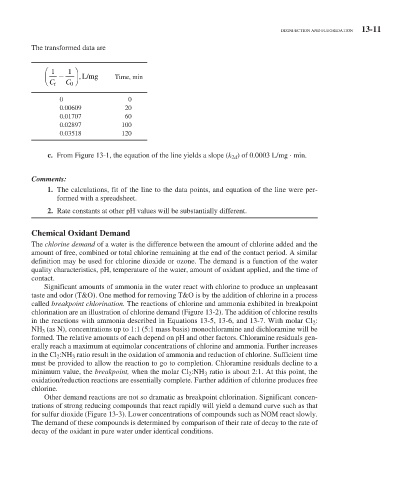Page 516 - Water and wastewater engineering
P. 516
DISINFECTION AND FLUORIDATION 13-11
The transformed data are
⎛ 1 1 ⎞
⎜ ⎝ C t C ⎠ ,L/mg Time, min
⎟
0
0 0
0.00609 20
0.01707 60
0.02897 100
0.03518 120
c. From Figure 13-1 , the equation of the line yields a slope ( k 2 d ) of 0.0003 L/mg · min.
Comments:
1. The calculations, fit of the line to the data points, and equation of the line were per-
formed with a spreadsheet.
2. Rate constants at other pH values will be substantially different.
Chemical Oxidant Demand
The chlorine demand of a water is the difference between the amount of chlorine added and the
amount of free, combined or total chlorine remaining at the end of the contact period. A similar
definition may be used for chlorine dioxide or ozone. The demand is a function of the water
quality characteristics, pH, temperature of the water, amount of oxidant applied, and the time of
contact.
Significant amounts of ammonia in the water react with chlorine to produce an unpleasant
taste and odor (T&O). One method for removing T&O is by the addition of chlorine in a process
called breakpoint chlorination. The reactions of chlorine and ammonia exhibited in breakpoint
chlorination are an illustration of chlorine demand ( Figure 13-2 ). The addition of chlorine results
in the reactions with ammonia described in Equations 13-5 , 13-6 , and 13-7 . With molar Cl 2 :
NH 3 (as N), concentrations up to 1:1 (5:1 mass basis) monochloramine and dichloramine will be
formed. The relative amounts of each depend on pH and other factors. Chloramine residuals gen-
erally reach a maximum at equimolar concentrations of chlorine and ammonia. Further increases
in the Cl 2 :NH 3 ratio result in the oxidation of ammonia and reduction of chlorine. Sufficient time
must be provided to allow the reaction to go to completion. Chloramine residuals decline to a
minimum value, the breakpoint, when the molar Cl 2 :NH 3 ratio is about 2:1. At this point, the
oxidation/reduction reactions are essentially complete. Further addition of chlorine produces free
chlorine.
Other demand reactions are not so dramatic as breakpoint chlorination. Significant concen-
trations of strong reducing compounds that react rapidly will yield a demand curve such as that
for sulfur dioxide ( Figure 13-3 ). Lower concentrations of compounds such as NOM react slowly.
The demand of these compounds is determined by comparison of their rate of decay to the rate of
decay of the oxidant in pure water under identical conditions.

